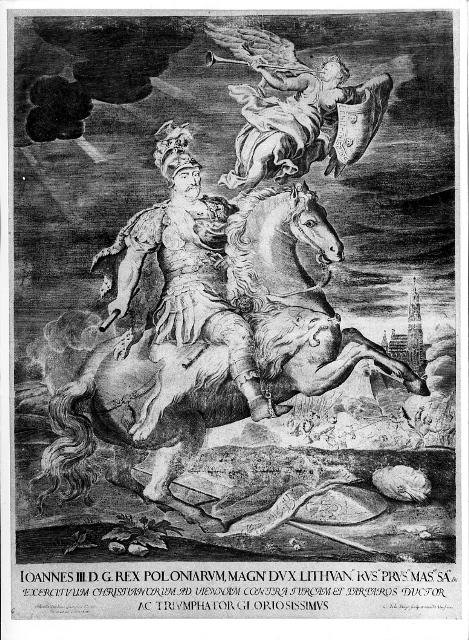
The most magnificent printed portraits of King Jan III Sobieski created at the end of the seventeenth century in Poland include the equine effigy made and published in Warsaw by Charles de La Haye, based on the concept and drawing (perhaps also a painting?) by Jerzy Eleuter Szymonowicz-Siemiginowski. This formal copperplate engraving measuring 61 x 44.5 cm, also called The Apotheosis of Jan III, glorifies Sobieski as the saviour of Vienna (this fact is reminded by the tower of St Stephen’s Cathedral visible in the background) and of the contemporary Christian world from the threatening Ottoman power. The monarch is represented as a leader, modelled after a Roman emperor, seated on horseback of a rearing-up horse, and is dressed in an antique scaled armour and a bascinet. The glory of the invincible Polish Lion (symbolized by attributes of Hercules and the Turkish trophies scattered underneath the horse’s hooves) is proclaimed by the floating winged Pheme with a shield that also symbolizes the Sobieskis’ Janina coat of arms.
Apart from the inscription, the copperplate engraving bears a signature (Humill. Subditus Georgius Eleuter / Invenit et delineavit C. de la Haye Sculp. et excudit Varsavia) of high importance to scholars. It enables them not only to specify the date of the print’s creation as ca. 1690 (that year the artist moved to Warsaw), but also indicates that Siemiginowski’s composition was originally meant for printing. Had it been based on an existing painted model, the engraving would contain the word pinxit. The issue is not entirely clear, as still unsolved remains the problem of mutual relation between the engraving and the well-known painting attributed to Siemiginowski, found in the National Museum in Warsaw. Some scholars claim that it was the said painting that was later copied as a print by La Haye. Others propose the opposite hypothesis, namely that the print served as a model for the later painting (of mediocre artistic quality). In any case, the large dimensions of La Haye’s print suggest that it was executed as a formal royal commission. Rich in complex symbolism, the print became very popular and served as a model for numerous oil copies as well as for weaving manufactures, even as late as in the eighteenth century. It was frequently presented at various occasional exhibitions in Poland and abroad, mainly those related to the Relief of Vienna (1933, 1983).
Charles (Carl) de La Haye, based on a drawing (painting?) by Jerzy Eleuter Szymonowicz-Siemiginowski: Equestrian portrait of Jan III Sobieski, copperplate engraving, 1692 (?).
We would like to inform that for the purpose of optimisation of content available on our website and its customisation according to your needs, we use information stored by means of cookies on the Users' end devices. You can control cookies by means of your Internet browser settings. Further use of our website without change of the browser settings means that you accept the use of cookies. For more information on cookies used by us and to feel comfortable about this subject, please familiarise yourselves with our Privacy Policy.
✓ I understand